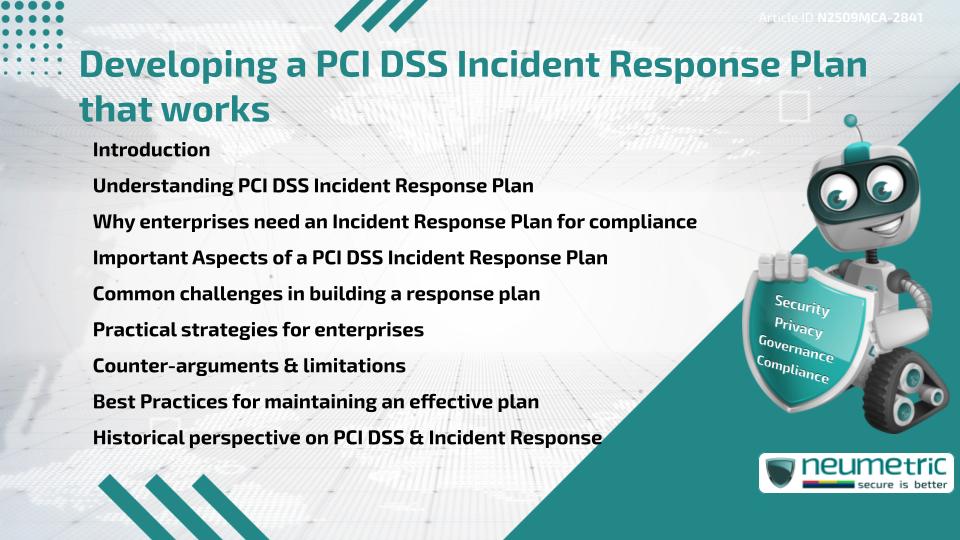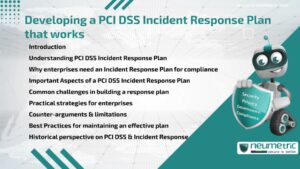Table of Contents
ToggleIntroduction
A PCI DSS Incident Response Plan is a critical requirement for enterprises handling Cardholder Data. It ensures that Organisations can detect, contain & remediate Security Incidents effectively. Without such a plan, enterprises face prolonged breaches, compliance penalties & loss of Customer Trust. This article explains what makes an effective Incident Response Plan, why it is essential for PCI DSS Compliance & how enterprises can overcome challenges in building one.
Understanding PCI DSS Incident Response Plan
The Payment Card Industry Data Security Standard [PCI DSS] requires enterprises to establish & maintain an Incident Response Plan. This plan outlines the steps to identify, analyze & mitigate data breaches or suspicious activities. According to the PCI Security Standards Council, Incident Response is one of the twelve (12) core requirements, designed to protect Cardholder Data from compromise.
Why enterprises need an Incident Response Plan for compliance
Cyberattacks often exploit the element of surprise. A PCI DSS Incident Response Plan ensures enterprises are prepared to act quickly, reducing the impact of Security Incidents. Beyond compliance, a structured response protects the organisation’s reputation, minimizes Financial losses & reassures Stakeholders that security is taken seriously. Guidance from ISACA emphasizes that Incident Response is as much about prevention as it is about recovery.
Important Aspects of a PCI DSS Incident Response Plan
An effective PCI DSS Incident Response Plan should include:
- Clear roles & responsibilities for response team members.
- Detection & analysis processes to identify incidents promptly.
- Containment procedures to limit the spread of an attack.
- Eradication & recovery steps to restore secure operations.
- Communication protocols for internal teams, regulators & affected Customers.
- Post-incident reviews to identify lessons & strengthen future defenses.
These components ensure a structured & effective approach to managing incidents.
Common challenges in building a response plan
Enterprises often struggle with defining clear responsibilities, testing their plans regularly & allocating sufficient resources. Smaller Organisations may lack dedicated security teams, while larger ones face coordination difficulties across departments. Furthermore, evolving Threats mean that plans can quickly become outdated if not regularly reviewed.
Practical strategies for enterprises
To build a PCI DSS Incident Response Plan that works, enterprises should:
- Conduct regular tabletop exercises & simulations.
- Train Employees to recognize & report incidents.
- Use automated tools for real-time detection & response.
- Align the Incident Response Plan with broader Business Continuity strategies.
Resources such as the NIST Computer Security Incident Handling Guide provide practical Frameworks that support PCI DSS Compliance.
Counter-arguments & limitations
Some argue that maintaining a PCI DSS Incident Response Plan is resource-intensive, especially for small enterprises. While this is true, the absence of a plan exposes Organisations to longer recovery times, higher costs & severe reputational damage. A well-designed plan scales to the size of the enterprise, ensuring even smaller Organisations can manage incidents effectively.
Best Practices for maintaining an effective plan
Enterprises must view Incident Response as an ongoing process, not a one-time setup. Best Practices include:
- Reviewing & updating the plan annually or after major incidents.
- Ensuring Third Party vendors comply with response requirements.
- Incorporating Threat Intelligence to adapt to evolving Risks.
- Documenting all incidents to support audits & learning.
Historical perspective on PCI DSS & Incident Response
When PCI DSS was first introduced, the focus was largely on prevention through strong controls. Over time, as cyberattacks grew more sophisticated, the need for structured Incident Response became clear. Historical data shows that enterprises with tested response plans recover faster & suffer less damage from breaches. Incident Response requirements in PCI DSS evolved to address this gap, making them a cornerstone of modern compliance.
Takeaways
- A PCI DSS Incident Response Plan ensures quick & effective handling of Security Incidents.
- Important Aspects include detection, containment, communication & recovery.
- Enterprises face challenges in defining roles & keeping plans updated.
- Practical strategies include simulations, training & integration with Business Continuity.
- Regular reviews & updates are essential for long-term compliance.
FAQ
What is a PCI DSS Incident Response Plan?
It is a documented set of procedures for detecting, responding to & recovering from Security Incidents involving Cardholder Data.
Why is an Incident Response Plan required for PCI DSS Compliance?
Because it ensures enterprises can respond effectively to breaches, minimizing Risks & meeting compliance Standards.
Who should be part of the Incident Response team?
IT, security, legal, compliance & communication staff should all be represented.
How often should Incident Response plans be tested?
Plans should be tested at least annually & after significant changes in systems or processes.
Can small enterprises manage a PCI DSS Incident Response Plan effectively?
Yes, by scaling the plan to their size & leveraging external support if needed.
How does Incident Response align with Business Continuity?
Incident Response is part of Business Continuity, ensuring critical operations can resume quickly after disruptions.
What role do vendors play in Incident Response?
Vendors with access to Cardholder Data must follow the same response requirements & coordinate with the enterprise’s plan.
References
- PCI Security Standards Council – PCI DSS Overview
- NIST – Cybersecurity Framework
- ISACA – IT Audit and Assurance
- Council of Europe – Data Protection and Privacy
Need help for Security, Privacy, Governance & VAPT?
Neumetric provides organisations the necessary help to achieve their Cybersecurity, Compliance, Governance, Privacy, Certifications & Pentesting needs.
Organisations & Businesses, specifically those which provide SaaS & AI Solutions in the Fintech, BFSI & other regulated sectors, usually need a Cybersecurity Partner for meeting & maintaining the ongoing Security & Privacy needs & requirements of their Enterprise Clients & Privacy conscious Customers.
SOC 2, ISO 27001, ISO 42001, NIST, HIPAA, HECVAT, EU GDPR are some of the Frameworks that are served by Fusion – a SaaS, multimodular, multitenant, centralised, automated, Cybersecurity & Compliance Management system.
Neumetric also provides Expert Services for technical security which covers VAPT for Web Applications, APIs, iOS & Android Mobile Apps, Security Testing for AWS & other Cloud Environments & Cloud Infrastructure & other similar scopes.
Reach out to us by Email or filling out the Contact Form…





